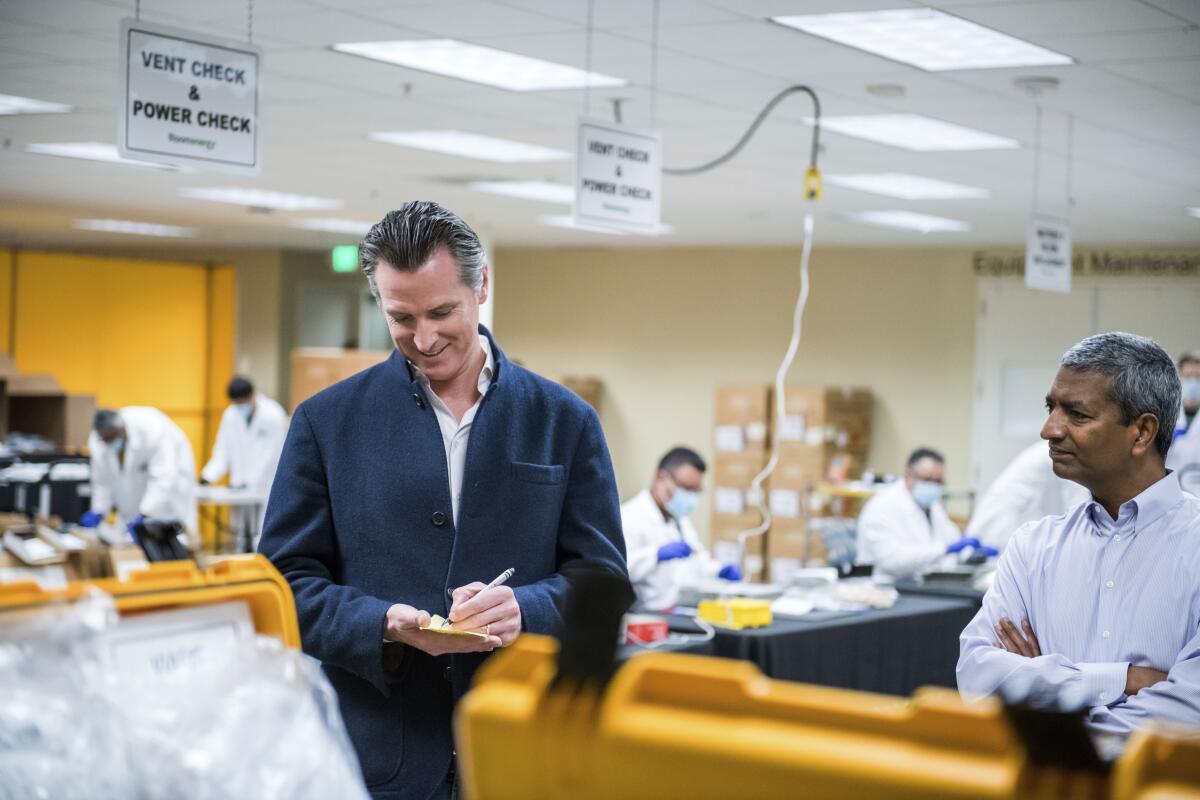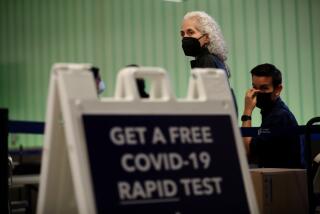California counties scrambling to find ventilators as Newsom sends 500 to other states fighting coronavirus

- Share via
SACRAMENTO — Gov. Gavin Newsom’s decision to lend 500 state-owned ventilators to New York and other coronavirus hot spots outside California has caught some local officials in his own state off guard as they scramble to acquire the much-needed medical equipment, particularly in Riverside County.
Riverside County officials said the state recently denied their request for an additional 500 ventilators, even though the county expects demand for the breathing machines at county hospitals and medical centers to exceed the supply in less than three weeks.
Santa Clara County, another area hard hit by the COVID-19 pandemic, is offering a $1,000 bounty for each device it receives and has ordered companies with the devices to report their inventory to the county.
“I understand and respect what the governor is doing. But are we going to be able to get the assistance that we’re going to need in a week or two weeks out?” Riverside County Supervisor Kevin Jeffries said Wednesday. “I think we were all a little surprised. We’re all trying to prepare so we’re not like New York.”
Newsom on Thursday said the state was able to lend the 500 ventilators to other states because California had an excess supply of the devices and those areas were in desperate need.
These are some of the unusual new scenes across the Southland during the coronavirus outbreak.
The governor said California hospitals reported that they are currently using only 31% of the ventilators they have, meaning 8,000 of the breathing machines are available for future COVID-19 patients who might need them. That number does not include the ventilators in the state stockpile, he said.
The governor defended his decision, saying it was the “right thing to do” and emphasizing that the ventilators will be returned to California when needed.
“We can’t just sit on assets when we can save lives and help our fellow Americans, so I just want to clear up any anxiety in that space or any ambiguity or any misinformation,” Newsom said during his daily COVID-19 briefing in Sacramento on Thursday.
Hospitals throughout California have procured thousands of ventilators in the last few weeks, increasing their total inventory to 11,747 from 7,587. An additional 1,000 refurbished ventilators are expected to become available in coming days and weeks, the governor said.
Newsom said that one reason California can afford to spare ventilators, at least for now, is because the vast majority of Californians have heeded orders to stay at home and, when they go out for essential purposes, they have also maintained the recommended social distancing from others.
That has helped slow the spread of infections as well as the number of hospitalizations and deaths, he said, allowing California to avoid the paths of hot spots such as New York and Italy. State health officials expect the coronavirus peak to hit the state sometime in May.
“These are lent. They are not given,” Newsom said Monday.
Jeffries said Riverside County had an agreement to purchase 300 new ventilators from a medical supply company for $12 million, but the deal has since been canceled. He said he was told that the Federal Emergency Management Agency instead acquired those ventilators to add to the Strategic National Stockpile.
“As far as we know, we’re dead in the water,” Jeffries said.
A FEMA spokesperson said the agency does not directly purchase ventilators, but does does help the U.S. Department of Health and Human Services and Department of Defense acquire the medical devices.
The governor said the California Emergency Medical Services Authority constantly monitors the availability of ventilators statewide and has positioned stockpiles of the medical devices strategically around the state so that they can be rapidly delivered to hospitals and medical centers that need them.
Mark Ghaly, secretary of the California Health and Human Services Agency, said the state also keeps a close eye on rural hospitals that have only a limited number of ventilators, knowing that even a small increase in coronavirus patients might push the facilities past capacity.
State officials are “checking in with them continuously, making sure that we prioritize their needs so that every hospital has enough to be able to serve the surge that we anticipate,” Ghaly said.
Although Riverside County expects to need ventilators when a predicted surge of coronavirus patients hits in late April, 305 of the 512 ventilators currently in the county were not in use as of Wednesday morning, according to county spokeswoman Brooke Federico.
County heath officials estimate that all the ventilators will be in use by April 26.
Federico said the county had initially requested 500 ventilators from the state, which was denied. The county later submitted a separate request for 1,000 ventilators that is pending.
Testifying before the county Board of Supervisors on Tuesday, Riverside County Emergency Management Department Director Bruce Barton said the state did not explain why it denied the county’s first request for ventilators.
“I just want people to know that we have been working on it,” Supervisor Karen Spiegel said at the meeting. “It’s beyond our control.”
Riverside joins counties across the state also scrambling to acquire ventilators and protective gear for healthcare workers.
Santa Clara County issued an order Wednesday asking individuals and businesses to report any large inventories of personal protective equipment and ventilators in anticipation of a forthcoming shortage as COVID-19 cases continue to rise. The county has a sufficient supply of equipment, but officials are preparing for an imminent need for more supplies beyond what the state and federal governments may be able to provide in the future. The order came a day after the county confirmed 1,380 COVID-19 cases and 46 deaths.
“The intent is to ensure we have comprehensive collective information about what PPE exists across the community,” said Dr. Sara Cody, the county’s public health officer.
Officials anticipate that most people would not need to report any equipment. The personal information of those who do will remain confidential, County Counsel James Williams said.
Individuals and businesses that have more than a minimum supply of equipment are expected to report to the county by April 15. That includes anyone with more than 5,000 nitrile or vinyl gloves; more than 500 N95 masks; more than 500 surgical masks; more than 100 safety goggles or face shields; more than a gallon of hand sanitizer; and any ventilators.
The masks are among the most coveted supplies needed in hospitals and medical facilities that are treating people infected with the coronavirus amid a nationwide shortage of personal protective equipment for healthcare workers.
“The order is about protecting the people who protect us,” Williams said. “We’re sheltering at home. These people are out there on the front lines protecting people who are infected. We need to protect the protectors.”
Cindy Chavez, president of the Santa Clara County Board of Supervisors, said the county isn’t in need of more ventilators at the moment, “but we can’t predict what we’re going to need in the weeks ahead. In Santa Clara County we have to make sure that we have ventilators for every person in our community who may need one.”
Newsom said Tuesday that California had secured a monthly supply of 200 million N95 respiratory and surgical masks to help protect healthcare workers. Delivery of the masks should begin in about a month, spokesman Nathan Click said.
The new effort will cost the state $495 million, according to a budget document that the Newsom administration submitted to the Legislature. In all, according to the document, the state has committed to purchasing medical safety gear that will cost $1.4 billion.
Mark Ghilarducci, director of the Governor’s Office of Emergency Services, said Wednesday that supplying personal protective equipment to Santa Clara and Riverside counties — along with Los Angeles, Orange, San Joaquin, San Francisco, Alameda, Sacramento and San Mateo counties — is considered the state’s top priority.
“It’s not just random,” he said. “This is closely coordinated with where we’re seeing the greatest number of cases that we have to manage, and that doesn’t mean that the rest of our counties in the state are not going to get” personal protective equipment.
More to Read
Sign up for Essential California
The most important California stories and recommendations in your inbox every morning.
You may occasionally receive promotional content from the Los Angeles Times.














